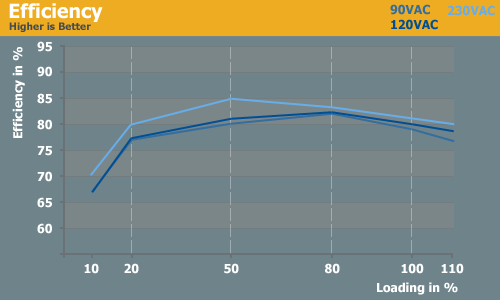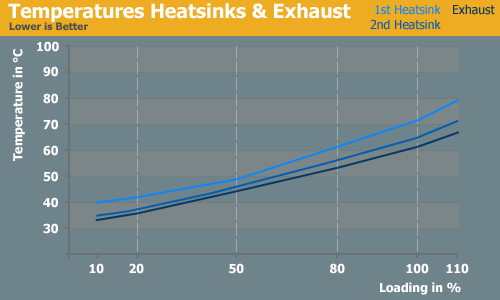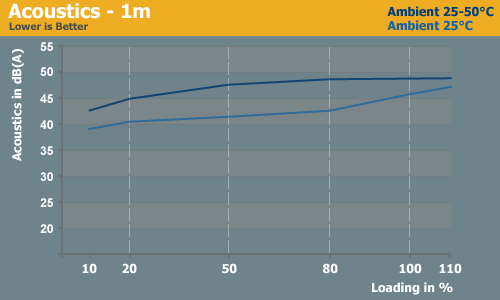Ultra High-End PSU Roundup
by Christoph Katzer on October 22, 2007 6:00 AM EST- Posted in
- Cases/Cooling/PSUs
PCP&C 1200W Efficiency, Temperatures, Fan Speed and Acoustics

With high input voltage the efficiency reaches up to 85% at a medium load of 600W. In general it always stays above 80% and doesn't go lower even at a 110% load. With lower input voltage such as 90 and 120VAC the levels are just average and only reach maximum efficiency at loads of around 900W - where it achieves a decent 83% efficiency. While 83% efficiency at 900W might be good, most systems that would require such a PSU will likely not be running at 900W load constantly. It should be possible to improve efficiency at other loads, but it seems likely that the unique design/layout PCP&C uses is playing a role.


During our first round of testing our temperature probe broke and we saw more than 1000°C on our thermometer. This is the second round of new probes we've had to install, a testament to the extreme conditions that can be found inside our testing chamber. Since the Turbo Cool has double the number of components of a "normal" power supply but also just "half" the load on each of the bridges, we actually expected the temperatures to be a little higher than we finally measured. Given there are three heat sinks, the primary in this graph is the top heat sink and by secondary we mean the two lower heat sinks.
The temperature delta from minimum to maximum load during testing is around 25°C at room temperature and as much as 40°C in the heat chamber. The temperature difference on the primary heat sink between the two environments starts at 5°C and reaches a maximum 18°C; this means that the primary heat sink is generally quite hot regardless of ambient temperature. Looking at the heat chamber testing, all of the measurements show a similar increase; this is good as it indicates the heat is at least getting out of the power supply and doesn't stick around to cook any of the components. To help make this possible PCP&C installed a Delta fan that can reach speeds of up to 4900 RPM.


We actually needed to extend our table to show the RPM of the Delta fan properly since we couldn't imagine finding a modern PSU with a fan that could almost hit 5000 RPM. Even at low temperatures we already measure almost 3500 RPM under room temperature. Starting with 30°C in the heat chamber the fan is already almost 1000 RPM higher. With these fan speeds the measured sound levels are hardly surprising. Please note the above measurements are taken at a distance of one meter! With its noise level of 50dB(A), this power supply tops even the Silencer 750 QUAD and is now the new leader of the non-silent power supplies faction. Once again, this loud fan is needed because there's no other reasonable way to get the heat out of the case with all the obstacles in the way of a proper airflow. High power with limited airflow pretty much necessitates the use of noisy cooling fans; this PSU would fit right in with many datacenter cooling racks.

With high input voltage the efficiency reaches up to 85% at a medium load of 600W. In general it always stays above 80% and doesn't go lower even at a 110% load. With lower input voltage such as 90 and 120VAC the levels are just average and only reach maximum efficiency at loads of around 900W - where it achieves a decent 83% efficiency. While 83% efficiency at 900W might be good, most systems that would require such a PSU will likely not be running at 900W load constantly. It should be possible to improve efficiency at other loads, but it seems likely that the unique design/layout PCP&C uses is playing a role.


During our first round of testing our temperature probe broke and we saw more than 1000°C on our thermometer. This is the second round of new probes we've had to install, a testament to the extreme conditions that can be found inside our testing chamber. Since the Turbo Cool has double the number of components of a "normal" power supply but also just "half" the load on each of the bridges, we actually expected the temperatures to be a little higher than we finally measured. Given there are three heat sinks, the primary in this graph is the top heat sink and by secondary we mean the two lower heat sinks.
The temperature delta from minimum to maximum load during testing is around 25°C at room temperature and as much as 40°C in the heat chamber. The temperature difference on the primary heat sink between the two environments starts at 5°C and reaches a maximum 18°C; this means that the primary heat sink is generally quite hot regardless of ambient temperature. Looking at the heat chamber testing, all of the measurements show a similar increase; this is good as it indicates the heat is at least getting out of the power supply and doesn't stick around to cook any of the components. To help make this possible PCP&C installed a Delta fan that can reach speeds of up to 4900 RPM.


We actually needed to extend our table to show the RPM of the Delta fan properly since we couldn't imagine finding a modern PSU with a fan that could almost hit 5000 RPM. Even at low temperatures we already measure almost 3500 RPM under room temperature. Starting with 30°C in the heat chamber the fan is already almost 1000 RPM higher. With these fan speeds the measured sound levels are hardly surprising. Please note the above measurements are taken at a distance of one meter! With its noise level of 50dB(A), this power supply tops even the Silencer 750 QUAD and is now the new leader of the non-silent power supplies faction. Once again, this loud fan is needed because there's no other reasonable way to get the heat out of the case with all the obstacles in the way of a proper airflow. High power with limited airflow pretty much necessitates the use of noisy cooling fans; this PSU would fit right in with many datacenter cooling racks.










27 Comments
View All Comments
alilxmas - Sunday, May 10, 2009 - link
At the end the reviewer had no personal preference, kinda left it off in mid sentence there... at least to me.Anyway some people do have to get the latest and do need a i7 CPU, multiple GPU's, slight OC, 6 hard drives, 3 monitors, etc.
Heres some things I do besides gaming,
Encoding videos from about 6-8 hours a day recorded footage sent from people who drop off anything from their safari trip to a wedding converted to dvd, formatted for their DSi or i-touch.
Processing RAW files (about 20mb per pic)
3-D Animation and models
Also for the air problem a slight mod can fix almost anything.
alilxmas - Sunday, May 10, 2009 - link
At the end the reviewer had no personal preference, kinda left it off in mid sentence there... at least to me.Anyway some people do have to get the latest and do need a i7 CPU, multiple GPU's, slight OC, 6 hard drives, 3 monitors, etc.
Heres some things I do besides gaming,
Encoding videos from about 6-8 hours a day recorded footage sent from people who drop off anything from their safari trip to converted to dvd, formatted for their DSi or i-touch.
Processing RAW files
3-D Animation and models
Also for the air problem a slight mod can fix almost anything.
Christoph Katzer - Tuesday, November 6, 2007 - link
Housten: We have Ripple, please confirm we have Ripple... the world makes sense again!TheOtherRizzo - Tuesday, October 30, 2007 - link
The efficiency graphs don't start before 20%. 20% is 250W. That's a lot more than an average computer uses on idle. So the tests don't tell me what these "Hi end" PSU's will do to my power bill and heat/noise output.strikeback03 - Tuesday, October 30, 2007 - link
The "average computer" also does not need a 1200W+ PSU. Look at Jarred's power usage numbers from the Blackbird test (linked above) - used 370W at idle and 740 at load.Fallen Kell - Tuesday, October 23, 2007 - link
The power cord connection on the Cooler Master Real Power Pro is NOT proprietary! That is a standard IEC-320-C19/C20 power connector. It is typically used for high power draw situations, (i.e. like 208V 20amp circuits, not your standard home 110V 15amp). This is actually a good thing for use in this situation. At full load, and the 80% efficiency associated with it, this power supply will need 14amps on your standard 110V outlet. That is not something your standard home wiring and sockets are designed to do. Many will only be rated for 10-12 amps per socket, 15amps for the entire circuit! By using a different connector like this, it will force people to use the appropriate rated wire and sockets, because this beast will draw more power then that basic home wiring can dish out without melting down and becoming a fire hazard.strikeback03 - Tuesday, October 30, 2007 - link
Didn't mention if the wall connector is different. However using the different connector at the PSU will make it harder to use an inadequate power cable from wall to PSU. The Infiniti 650W PSUs we used in a few recent builds had larger-than-normal power cords, I would imagine a 1200W PSU needs a cable that is larger yet.JarredWalton - Tuesday, October 23, 2007 - link
Ummm... the socket on the back of the PSU is different. The main connector on the other end is still standard, AFAIK.Bozo Galora - Monday, October 22, 2007 - link
heres another review of the same PCP&C PSUhttp://www.pcper.com/article.php?aid=458&type=...">http://www.pcper.com/article.php?aid=458&type=...
here he gives volatges given at both at PSU and at ATX connector with a discussion about it.
No other in depth PSU reviews show the lowering degree of V with load that yours consistently do for some reason.
Christoph Katzer - Tuesday, October 23, 2007 - link
Just have a look at the loading diagram, I am testing strictly according to Intel specs and have ~20A on 3.3 and ~24A on 5V. There I see only ~16-17 amps on both. That the voltage regulation works better with less load should be quite clear. Compare the loads and not only voltage.